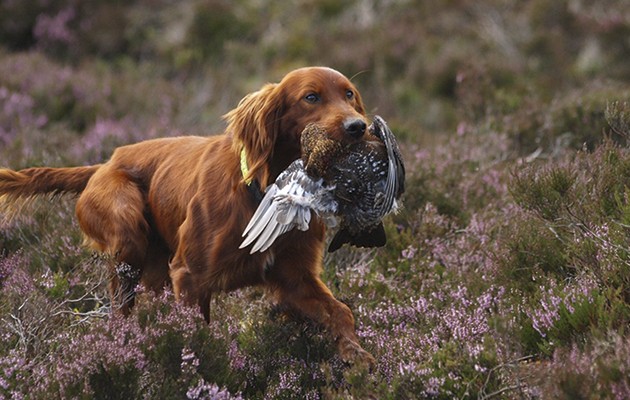Our pointers and setters have a retrieving instinct but over the past 200 years we’ve suppressed it. David Tomlinson reckons it’s time to turn back the clock
The retrieving instinct comes naturally to our pointers and setters, but over time we have supressed it, relying instead on our spaniels and labradors. David Tomlinson encourages training pointers and setters to do what comes naturally.
For more on gundogs, read gundog retirement: looking after an old dog or outbreeding: essential for gundog survival?
THE RETRIEVING INSTINCT
Like many Italian sportsmen, Andrea Rizzo is passionate about his shooting, but if he had to choose between his Beretta and his English setters, the latter would win every time. “I don’t understand you British,” he told me once. “You have produced the most beautiful gundogs in the world, the setters, but you don’t use them. They are the Ferraris of the dog world: they look wonderful even when they’re not doing anything. Instead, you import pointers from Germany, even spinoni from Italy. Why?”
There is, of course, a big difference between Rizzo’s setters and almost all the working setters you are likely to meet in the British Isles. His dogs use their retrieving instinct, our dogs don’t. His dogs are genuine HPRs: they hunt with enthusiasm, point as solidly as Lord Kitchener, and retrieve tenderly. In contrast, our setters are simply HPs, which makes them sound more like a bottle of sauce than a hunting dog. Once, we expected our setters and pointers to use their retrieving instinct, and there are numerous old paintings and prints to prove it, but that was a couple of hundred years ago.
Our setter and pointer field trials are unique, for they test the dogs’ ability to quarter and hunt, even their steadiness on point, but birds are never shot, though they will be saluted by the accompanying gun. This isn’t a cost-saving measure (though it does make these trials more affordable). It is because, on a traditional day shooting grouse over pointing dogs, labradors and spaniels are relied on for the retrieving. The argument has always been that the pointers and setters have done their work by locating the birds – encouraging their retrieving instinct could easily make them unsteady and put them at risk of being shot.
TOP HANDLERS AND THE RETRIEVING INSTINCT
However, if you speak to the leading setter and pointer handlers who take their dogs shooting, you will discover that most have had an occasional dog with a keen retrieving instinct.
One of our top handlers, Peter O’Driscoll, told me that his best-ever pointer, Slezak, pointed wounded birds and retrieved any that were dead. Slezak was the first dual champion in the breed for 60 years. All our working-bred pointers and setters have a retrieving instinct but we have long done our best to suppress it.
Des O’Neile of Glencuan Pointers was one of the top pointer handlers in Northern Ireland, but he died last autumn. Not long before his death he changed his policy on the retrieving instinct: “For years I didn’t teach my dogs to retrieve – there was no reason to as they wouldn’t be required to do so in a trial. I thought that I would run the risk of encouraging them to be unsteady. I no longer believe this to be true, and study of pointers in Europe, where they’re usually required to retrieve, suggests that a correctly trained retrieving pointer is less likely to run in, and a retrieving dog also appears to be a harder hunter.”
O’Neile was one of the first handlers to start training his dogs to retrieve but an increasing number are now also encouraging the retrieving instinct. A major incentive is the chance to compete in Continental competitions, where retrieving is an essential part of the test. Last autumn GB entered its first official team in the 37th World Championship for hunting dogs, in Serbia. The Championship includes several different events, with the Championnat du Monde Inglesi reserved exclusively for pointing breeds that originated in Britain – pointers and setters.
Needless to say, it has never been won by a British handler as none had entered until last autumn’s event when Britain’s Maddy Raynor came a creditable 15th overall with her Irish setter, Ginger. It was an encouraging start and I’ve no doubt that this year’s team will be better prepared as they will know what to expect when they enter the competition in Denmark.
A MEMORABLE DAY WITH RETRIEVING SETTERS
Last summer I spent a memorable day on the North Yorkshire moors, watching Raynor and her mother Sara preparing their dogs for the World Championship. It was a classic day’s shooting over setters except that the setters were, on occasion, asked to retrieve. They were backed up by a labrador, an English springer and a labradoodle: asking the setters to undertake every retrieve could make them unsteady.
During the day I witnessed several excellent retrieves, both by Ginger, the Irish setter, and Sara Raynor’s Gordon setters. They proved to be both steady and impressively competent. If you hadn’t known that they were newcomers to the art of picking birds you would have thought that they had been doing it for years. This wasn’t so surprising, as they were only doing what Continental dogs actually have been doing for years.
We shouldn’t expect an overnight revolution, with all handlers teaching their pointers and setters to retrieve, yet I have no doubt that increasing numbers of these dogs will be taught how to become all-round shooting companions.
It might even give a much-needed boost to their popularity here, where they were originally developed and refined.





